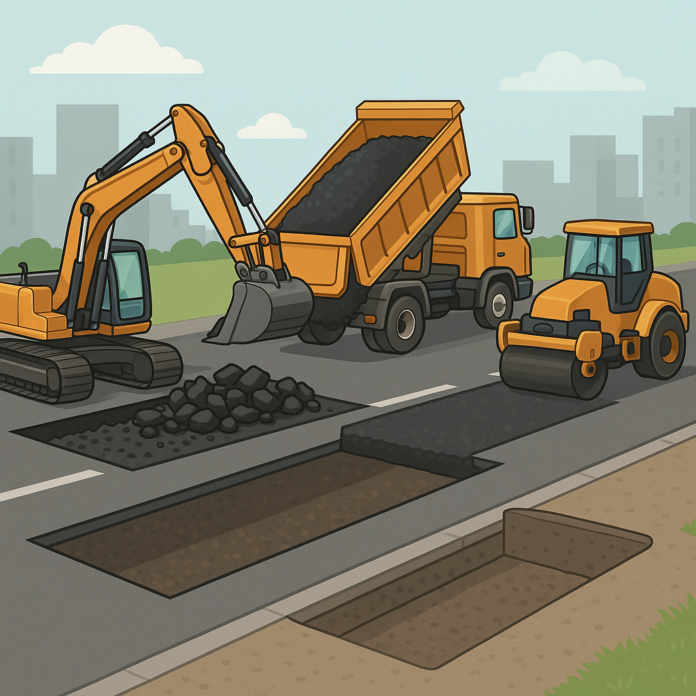Introduction to Road Surface Repair
Road surface repair is a critical aspect of infrastructure maintenance that ensures safe and efficient transportation networks. Whether dealing with asphalt or concrete pavements, proper repair techniques are essential for extending road lifespan and maintaining traffic flow. This comprehensive guide explores various repair methods, from minor surface treatments to major reconstruction projects.
Major Asphalt Pavement Repairs Using Hot Mix Procedures
Initial Assessment and Preparation
When addressing significant localized damage on asphalt pavements, the repair process begins with thorough damage assessment. The first step involves removing all damaged asphalt layers completely. Following removal, contractors must evaluate the quality of the underlying base layer to determine the appropriate repair approach.
If the base layer quality is satisfactory, the surface should be graded and compacted properly before proceeding with the repair. However, when the base layer quality is inadequate, it becomes necessary to remove the poor material and replace it with suitable materials, followed by proper grading and compaction.
Surface Preparation Protocols
Surface preparation must be conducted according to established standards for dimensioning, based on the weighted equivalent daily traffic (TF). This preparation ensures that the surface can adequately support the expected traffic loads and environmental conditions.
Asphalt Layer Installation
The installation of asphalt mixture should be performed in the required number of consecutively constructed layers. Layer thickness is determined based on the maximum allowable aggregate size in the mixture and the available compaction equipment.
Asphalt layers must be installed to the bottom surface level of the surrounding pavement, maintaining a minimum of 3 cm below the existing road surface. This requires careful attention to edge compaction to achieve the required density specifications.
Final Layer Requirements
Before installing the wearing course, it’s essential to cut the existing wearing layer on the surrounding pavement. This step ensures proper integration between new and existing materials, creating a seamless repair that maintains structural integrity.
Concrete Pavement Repairs
Understanding Repair Applications
Hot mix asphalt repairs are frequently used for concrete pavement maintenance because they allow traffic to continue during construction with minimal restrictions or brief interruptions. However, these repairs can affect the aesthetic appearance and color continuity of the pavement, especially when repairs are localized and frequent.
Joint Sealing Procedures
Joint sealing represents one of the most common repairs for concrete pavements. This maintenance activity should be performed during dry weather conditions, with thorough cleaning of joints and cracks to remove dust, dirt, and loose or damaged sealant material.
For joints with exposed vertical surfaces, the concrete slab sides should be coated with hot bitumen to improve adhesion of the sealing material. The sealing material selection depends on the crack size and potential edge damage, following established standards for concrete pavement construction.
Specialized Joint Repair Techniques
Joints or cracks with damaged edges exceeding 45 cm in width require a two-step repair process. First, contractors install a 5 cm thick concrete layer, followed by sealing material application. For joints and cracks with damaged edges up to 5 cm wide, sealing material alone is sufficient.
Small cracks and fissures in concrete slabs up to 1 mm wide and 10 mm deep, resulting from curing processes and temperature gradients, typically don’t require closure. Larger cracks must be filled with a paraffin solution in trichloroethylene (1:10 ratio).
Surface Damage Repair Methods
When using concrete mortar or cement concrete for hole repairs, the hole bottom and edges must be moistened with water. Depending on the hole depth, contractors should use normal concrete mixture that matches the existing pavement quality in materials and gradation, or cement-sand mortar prepared in a 1:2 ratio with minimal water and calcium chloride addition to reduce setting time.
Layer thickness for these repairs ranges from 5 to 6 cm, with traffic allowable after 12 hours. Repaired surfaces must be protected from traffic and weather until concrete curing is complete, using appropriate concrete curing measures and proper traffic signage to prevent accidents.
Advanced Repair Techniques
Spray Concrete Applications
For extensive surface damage repairs, particularly when dealing with exposed aggregate, mortar loss, or excessive wear, spray concrete applications offer effective solutions. These materials are applied using specialized equipment or gunite application in single or multiple layers.
Specialized Materials
Modern repair techniques also include specialized mortars, compounds, or pastes prepared with epoxy resin bases. These materials provide enhanced durability and performance characteristics suitable for specific repair conditions.
Complete Slab Replacement
Severely cracked and deformed slabs require complete replacement, including demolition, removal, and construction of new slabs. This process often includes repair or replacement of materials in the subbase and base layers of the pavement structure.
Vertical Displacement Corrections
Road sections with concrete slabs that have risen or settled, preventing normal traffic flow, require repositioning to design elevations. This work includes addressing the underlying causes of deformation according to appropriate regulations and specifications.
When to Consider Reconstruction
In cases where pavement structure is inadequate for traffic loads or where long-term use has reduced performance characteristics to the point where maintenance and repair of numerous damages is uneconomical, reconstruction or strengthening of concrete pavement becomes necessary. Strengthening can be accomplished through installation of new concrete layers or alternative pavement systems.
Conclusion
Effective road surface repair requires careful assessment, proper material selection, and adherence to established procedures. Whether working with asphalt or concrete pavements, success depends on understanding the specific repair requirements and implementing appropriate techniques. Regular maintenance and timely repairs ensure optimal pavement performance and extend service life, ultimately providing safe and efficient transportation infrastructure.
The key to successful road surface repair lies in proper diagnosis, quality materials, skilled execution, and appropriate traffic management during construction. By following these guidelines, transportation agencies and contractors can maintain high-quality road networks that serve communities effectively for years to come.
